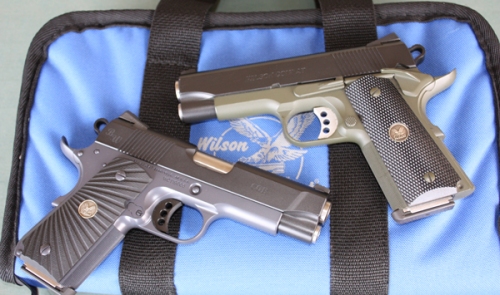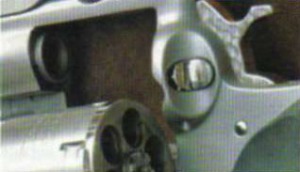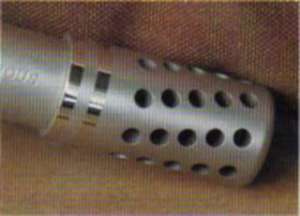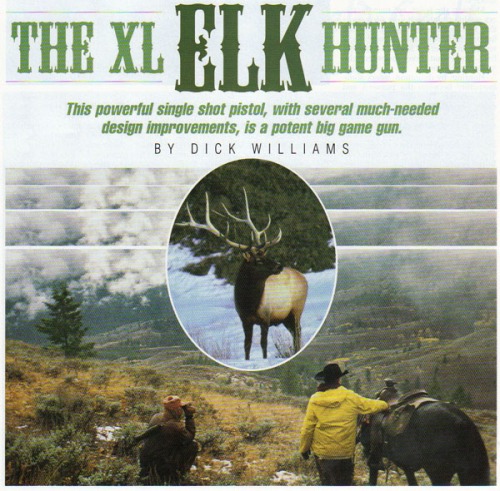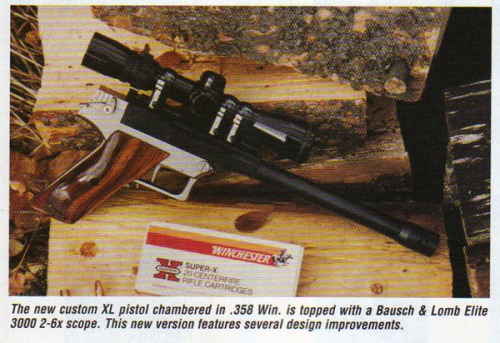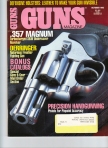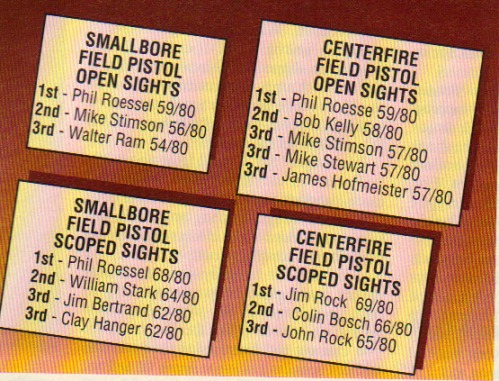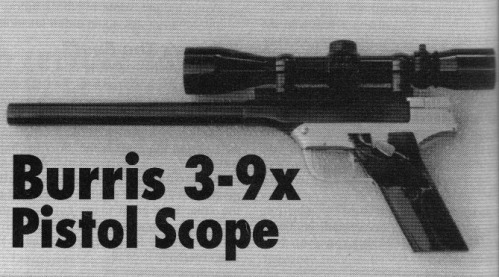Published in “Shooting Illustrated” August 2009
Bill Wilson is no stranger to the shooting world. His CQB pistol graced the cover of Shooting Illustrated’s November 2005 issue and was the subject of a full length feature entitled “The Perfect IDPA Pistol.”
Given IDPA’s emphasis on designing match scenarios that might duplicate potential real life street encounters, it was not surprising that much of my evaluation focused on CCW requirements in addition to match rules. Upon completion of the article, I purchased the CQB from Wilson, and it became the number one gun on my CCW permit. Until now, I did not expect to find an all-steel 1911 that I would prefer for street carry.
Wilson Combat recently created the Bill Wilson Carry Gun, and as you might expect when one is introducing the next generation of a great handgun, the new carry pistol is not vastly different from the successful CQB. That said the minor changes are truly worthwhile and quickly appreciated. Overall dimensions remain the same; a slide shortened from a standard 1911 to accommodate a 4.1 inch barrel, and a frame reduced in height to 5.25 inches overall (with the 7 shot magazine installed.) Like the CQB, the new model handles both the 7-round magazine (recommended for concealed carry) and slightly extended 8-round magazines that are easily concealed in spare carriers without revealing any unusual lumps or bulges. Internal configuration, cuts and polishing is essentially the same on both guns which accounts for the superb accuracy and reliability of a Wilson 1911.
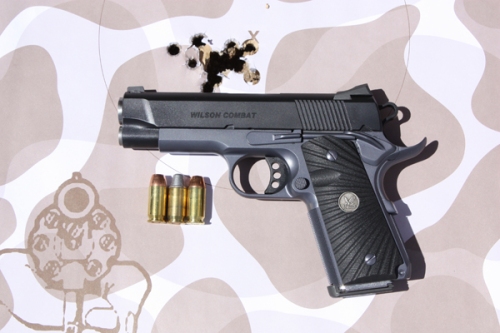
The first 15 rounds through the Wilson were a mix of bullet styles and weights. Functioning was perfect and, at the group at 15 yards offhand, indicate that whatever ammo is fed to the new gun, it will reliably handle any threats to its owners life and well being.
Most noticeable and having the greatest impact on my shooting the new gun is the modified Ed Brown bobtail on the shorter grip frame. Normally this rounding of the base is only done on full-size 1911. On the smaller frame, the curvature is not as severe, but the change is dramatic in terms of comfort during firing, and the more magazines fired in a range session, the more you’ll appreciate the increased comfort. Because of the bobtail treatment, the base had to be modified slightly making the gun feel a bit smaller, but shot-to-shot recovery didn’t seem to be compromised. The rounded edge of the back strap is fully checkered just as it is on the CQB, but there is no longer a distinct edge to create abrasions on your palm. A couple of years ago when I first acquired the CQB, I spent some time at Thunder Ranch and ended up applying bandages on the second day and changing guns on the third day. In a recent trip to Gunsite with the Carry Gun I was able to comfortably complete the week long class without having to apply any patches to my palm. For me, the bobtail is much more important on a downsized 1911 because the sharp edge of the backstrap doesn’t extend below the palm swell, but rather is driven into the meaty part of the hand by the recoil of each round. Given that steel is harder than flesh, can you say “Ouch!”
The other “comfort” revision is the G10 grips. These feature radial lines instead of checkering with the edges of each line slightly rounded. Tactile control is still excellent, but long term abrasion in an extended class is reduced. Call me a sissy if you like, but I like those grips. The single thumb safety lever, set up for right handed shooters, is smaller on the new carry gun. I think it’s a good idea if you can reduce the size of a component on a CCW weapon without compromising performance, and over the 5 day-class, I did not notice any difficulties in operation when presenting the gun from concealed carry. The slide stop pin has also been shortened with the frame countersunk on the right side. This change does two things. One, it will allow the use of Crimson Trace grips with no interference from a protruding pin. Second, you may need to modify your disassembly technique slightly when you clean the gun. There are also serrations on top of the new gun’s slide for the purpose of reducing glare. Firing both the old CQB and the new pistol in the bright Arizona sunlight I did not notice any difference in glare from either gun, but most of our outdoor shooting was during morning hours with the sun behind us. Still, I would rate this as a worth while addition on a carry gun.
The new gun has several relief cuts that strike me as being well thought out and useful. The front half inch or so of the slide has been reduced in width. It may not save much weight, but depending on how you execute a press check, you might find the new configuration helpful in grasping the slide with the support hand. There’s also a relief cut in the front strap just behind the trigger guard. Perhaps it let’s you get your hand in higher and tighter into the grip, but it’s so small that I really couldn’t notice a functional difference between the two guns either when holding or firing. The final relief cut is in the left grip panel behind the mag release button, and this did have some tangible benefits. I’ve never been able to drop a magazine on a 1911 without shifting my shooting hand grip simply because I don’t have particularly long fingers/thumbs. With Wilson’s new carry gun, I still have to rotate a bit, but it’s noticeably less movement than is required on the CQB, much more comfortable to execute, and much quicker to recover. This is the kind of change whose value will depend on your individual dimensions and operating technique for an evaluation, but even with only a partial improvement, I like the change.
The last change noticed was the “U” shaped notch in the fixed rear sight. I believe the purpose of this is to make sight acquisition a bit faster in a life-threatening situation. Perhaps it did, but I couldn’t tell. In fact, the entire time on the line I didn’t notice the difference. Sight pictures on both guns are extremely similar simply because you don’t see the bottom of the notch where it’s rounded. Neither could I detect any difference in the amount of light visible on both sides of the front blade, even when shooting slowly. The only thing that struck me as slightly different was that the first 15 shots fired offhand with three different Black Hills loadings at 15 yards seemed to have more of a lateral spread than usual. I know Wilson pistols shoot one-hole groups in the hands of testers at the factory shooting from a rest, and while I didn’t expect exactly the same results, I felt the vertical spread (about 1 ½ inches) was more representative than the horizontal spread of something like 2 ½ inches. As stated, when I got into the class, both worked superbly. For the record, I was wearing corrective lenses and I’m quite new to “U” notch rear sights.
I can’t fault the Wilson’s reliability. By being abusive, I was able to cause malfunctions, but it was only by breaking all the rules. After firing 2 to 3 boxes of ammo (without first cleaning the gun,) I put the gun away dirty and un-oiled for two weeks before going to Gunsite. Again without cleaning or lubricating, I shot the gun for two days of class. When the gun failed to go into battery, some oil cured the problem until late in the third day when the same failures reoccurred. Additional lubrication continued to cure the problem but for shorter periods of time. As the instructions state, clean the gun and it will (and did) work flawlessly. The only “failure” not attributed to my atrocious behavior was on the third day when the “Wilson” escutcheon in the left grip panel fell off. A call to John May in Arkansas revealed that this was one of those occasions where the least expensive adhesive worked the best and the expensive glue failed. Problem fixed forever.
I’ve succumbed to the Siren calls again. No, I’m not buying a new carry gun because my existing CQB is tied to my CCW permit by serial number, and changing things like this is California would be a nightmare. But I am having my CQB remodeled to the new Wilson Carry Gun. It’s that good.


